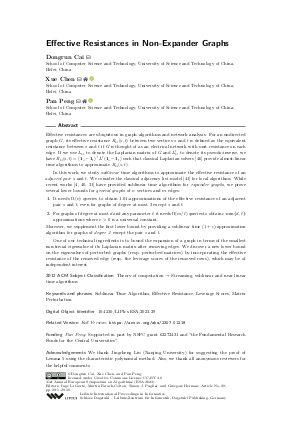@InProceedings{cai_et_al:LIPIcs.ESA.2023.29,
author = {Cai, Dongrun and Chen, Xue and Peng, Pan},
title = {{Effective Resistances in Non-Expander Graphs}},
booktitle = {31st Annual European Symposium on Algorithms (ESA 2023)},
pages = {29:1--29:18},
series = {Leibniz International Proceedings in Informatics (LIPIcs)},
ISBN = {978-3-95977-295-2},
ISSN = {1868-8969},
year = {2023},
volume = {274},
editor = {G{\o}rtz, Inge Li and Farach-Colton, Martin and Puglisi, Simon J. and Herman, Grzegorz},
publisher = {Schloss Dagstuhl -- Leibniz-Zentrum f{\"u}r Informatik},
address = {Dagstuhl, Germany},
URL = {https://drops.dagstuhl.de/entities/document/10.4230/LIPIcs.ESA.2023.29},
URN = {urn:nbn:de:0030-drops-186823},
doi = {10.4230/LIPIcs.ESA.2023.29},
annote = {Keywords: Sublinear Time Algorithm, Effective Resistance, Leverage Scores, Matrix Perturbation}
}

 Creative Commons Attribution 4.0 International license
Creative Commons Attribution 4.0 International license




































